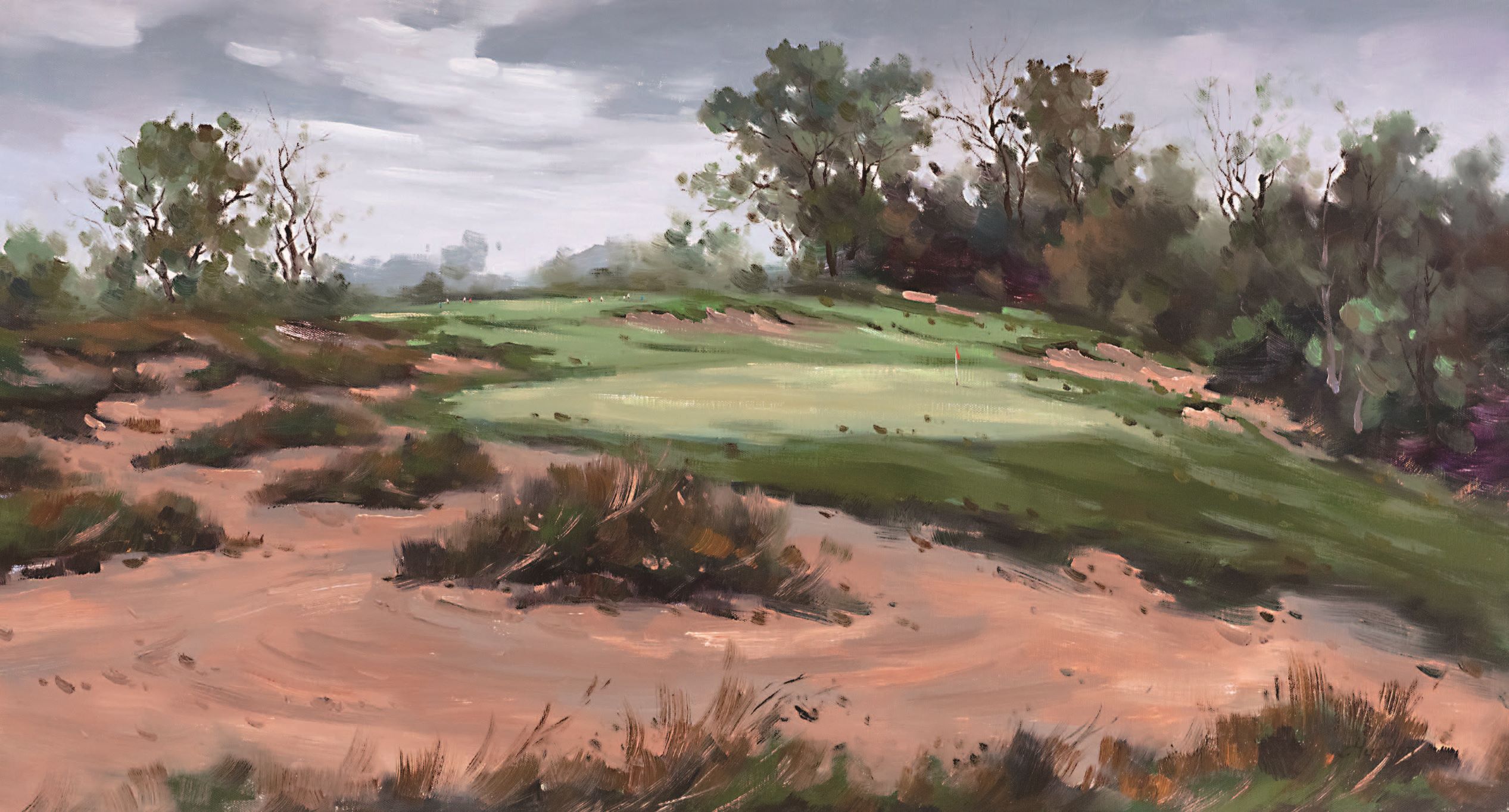
The Bellini Museum in Florence will host an exhibition of oil paintings by the artist Hudson Shaoxia Zhang, themed around golf courses, from June 22 to 30, 2024. The works reflect Zhang's passion for both artistic creation and golf. Having played on many golf courses around the world, he has created nearly a thousand landscapes with a unique style. Zhang has previously exhibited at the Nanjing Academy of Art, the University of London, and will have upcoming exhibitions at the Sorbonne, the University of Leuven, Columbia University, and other venues.

Hudson Shaoxia Zhang boasts over fifty years of artistic experience. In the late 1970s, he pursued a master's degree in Art History at the Nanjing Academy of Art, studying under Professor Liu Ruli. During his three years of postgraduate studies, he wrote a foreign art history manual that has been used in many Chinese art schools. Together with art critic Li Xiaoshan, he co-authored the book "History of Modern Chinese Painting," a fundamental work during the "85 New Wave Art Movement." In the 1980s, he dedicated himself to research and writing, publishing works such as "History of European Art and Craft" and "History of Asian Art and Craft," which are considered foundational in the study of foreign art and craft. In the early 21st century, he wrote other significant works such as "History of the Development of Western Art" and "Great Encyclopedia of World Art," greatly contributing to the study of foreign art history in China.

Oil painting is a universal artistic language, and as a Chinese artist, Hudson Shaoxia Zhang has deeply understood its principles and techniques, expressing a strong artistic personality. His choice to depict golf course landscapes gives his work a unique style and special significance. Golf, an ancient yet modern sport, symbolizes the harmony between man and nature. Through this theme, Zhang explores the interaction between golf course landscapes, nature, society, and the artist's inner world, layering meanings behind the images. This blend of traditional landscape painting and golf culture breathes new life into both.

Conceptually, Hudson Shaoxia Zhang does not strive for complete fidelity to realism. Art historian Simon Schama has said that "the truth of an image lies in a poetic truth, not a literal one." Zhang's golf course landscapes achieve a "poetic transformation" from reality to image, incorporating elements of expressionism and fauvism, emphasizing emotional experience and echoing romanticism. Zhang maintains a balance between likeness and unlikeness, rejecting both "super-realism" and "commercial works." As he himself states, "Even if there were another artist as passionate about painting golf courses as I am, painting the same course and the same hole at the same time, the result would be different. It's like trying to replicate Corot's Barbizon, Monet's water lilies, Morandi's bottles, or Hockney's Yorkshire." This is the beauty of his golf course landscapes.

Throughout art history, many artists have chosen to step away from artistic centers to find new directions: Thoreau discovered the beauty of nature at Walden Pond far from the bustle of Paris; the Southern California sun and Hollywood pools shaped the iconic David Hockney. Hudson Shaoxia Zhang uses elements of golf such as fairways, greens, and hazards to create artistic landscapes, challenging traditional landscape painting conventions and forging his own artistic legend.

This exhibition, marking the debut of Zhang's works in Italy, aims to create an opportunity for dialogue between the artist and a wider audience, building a bridge of communication between golf enthusiasts and art lovers.
Mostra personale di Hudson Shaoxia Zhang a Firenze
Il Museo Bellini di Firenze ospiterà una mostra di dipinti a olio a tema campi da golf dell'artista Hudson Shaoxia Zhang dal 22 al 30 giugno 2024. Le opere riflettono la passione di Zhang per la creazione artistica e il golf. Ha giocato in molti campi da golf nel mondo, creando quasi mille paesaggi con uno stile unico. Ha già esposto all'Accademia d'Arte di Nanchino, all'Università di Londra e terrà prossime mostre alla Sorbona, all'Università di Lovanio, alla Columbia University e altrove.
Hudson Shaoxia Zhang ha un'esperienza artistica di oltre cinquant'anni. Alla fine degli anni '70 ha frequentato il corso di laurea magistrale in Storia dell'Arte all'Accademia d'Arte di Nanchino, studiando con il professor Liu Ruli. Durante i tre anni di studi post-laurea, ha scritto un manuale di storia dell'arte straniera usato in molte scuole d'arte cinesi. Con il critico d'arte Li Xiaoshan, ha co-autore il libro "Storia della Pittura Moderna Cinese", fondamentale nel periodo della "Nuova Ondata d'Arte dell'85". Negli anni '80 si è dedicato alla ricerca e alla scrittura, pubblicando opere come "Storia dell'Arte e dell'Artigianato Europeo" e "Storia dell'Arte e dell'Artigianato in Asia", considerate le prime pietre miliari nello studio dell'arte e dell'artigianato straniero. All'inizio del XXI secolo, ha scritto altre opere importanti come "Storia dello Sviluppo dell'Arte Occidentale" e "Grande Enciclopedia dell'Arte Mondiale", contribuendo allo studio della storia dell'arte straniera in Cina.
La pittura a olio è un linguaggio artistico universale e, come artista cinese, Hudson Shaoxia Zhang ha compreso profondamente i principi e le tecniche, esprimendo una forte personalità artistica. La sua scelta di raffigurare paesaggi di campi da golf conferisce ai suoi lavori uno stile unico e un significato particolare. Il golf, sport antico e moderno, rappresenta l'armonia tra l'uomo e la natura. Attraverso questo tema, Zhang esplora l'interazione tra i paesaggi dei vari campi da golf, la natura, la società e l'interiorità dell'artista, stratificando significati dietro le immagini. Questo connubio tra pittura paesaggistica tradizionale e cultura del golf dona nuova vitalità a entrambi.
Dal punto di vista concettuale, Hudson Shaoxia Zhang non persegue una completa fedeltà al realismo. Lo storico dell'arte Simon Schama ha affermato che "la verità di un'immagine risiede in una verità poetica, non letterale". I paesaggi di campi da golf di Zhang realizzano una "trasformazione poetica" dalla realtà all'immagine, incorporando elementi dell'espressionismo e del fauvismo, sottolineando l'esperienza emotiva, rispondendo al romanticismo. Zhang mantiene un equilibrio tra somiglianza e non somiglianza, rifiutando sia il "super-realismo" sia le "opere commerciali". Come lui stesso afferma, "Anche se ci fosse un altro artista appassionato di dipingere campi da golf come me, che dipingesse lo stesso campo e la stessa buca nello stesso momento, il risultato sarebbe diverso. È come non poter replicare la Barbizon di Corot, le ninfee di Monet, le bottiglie di Morandi o lo Yorkshire di Hockney". Questa è la bellezza dei suoi paesaggi di campi da golf.
Nella storia dell'arte, molti artisti hanno scelto di allontanarsi dai centri artistici per trovare nuove strade: Thoreau ha scoperto la bellezza della natura nel Walden Pond lontano dal trambusto di Parigi; il sole della California del Sud e le piscine di Hollywood hanno plasmato l'iconico David Hockney. Hudson Shaoxia Zhang utilizza elementi del golf come i fairway, i green e gli ostacoli per creare paesaggi artistici, sfidando le convenzioni della pittura paesaggistica tradizionale e scrivendo la propria leggenda artistica.
Questa mostra, che segna il debutto delle opere di Zhang in Italia, mira a creare un'opportunità di dialogo tra l'artista e un pubblico più ampio, costruendo un ponte di comunicazione tra appassionati di golf e amanti dell'arte.






